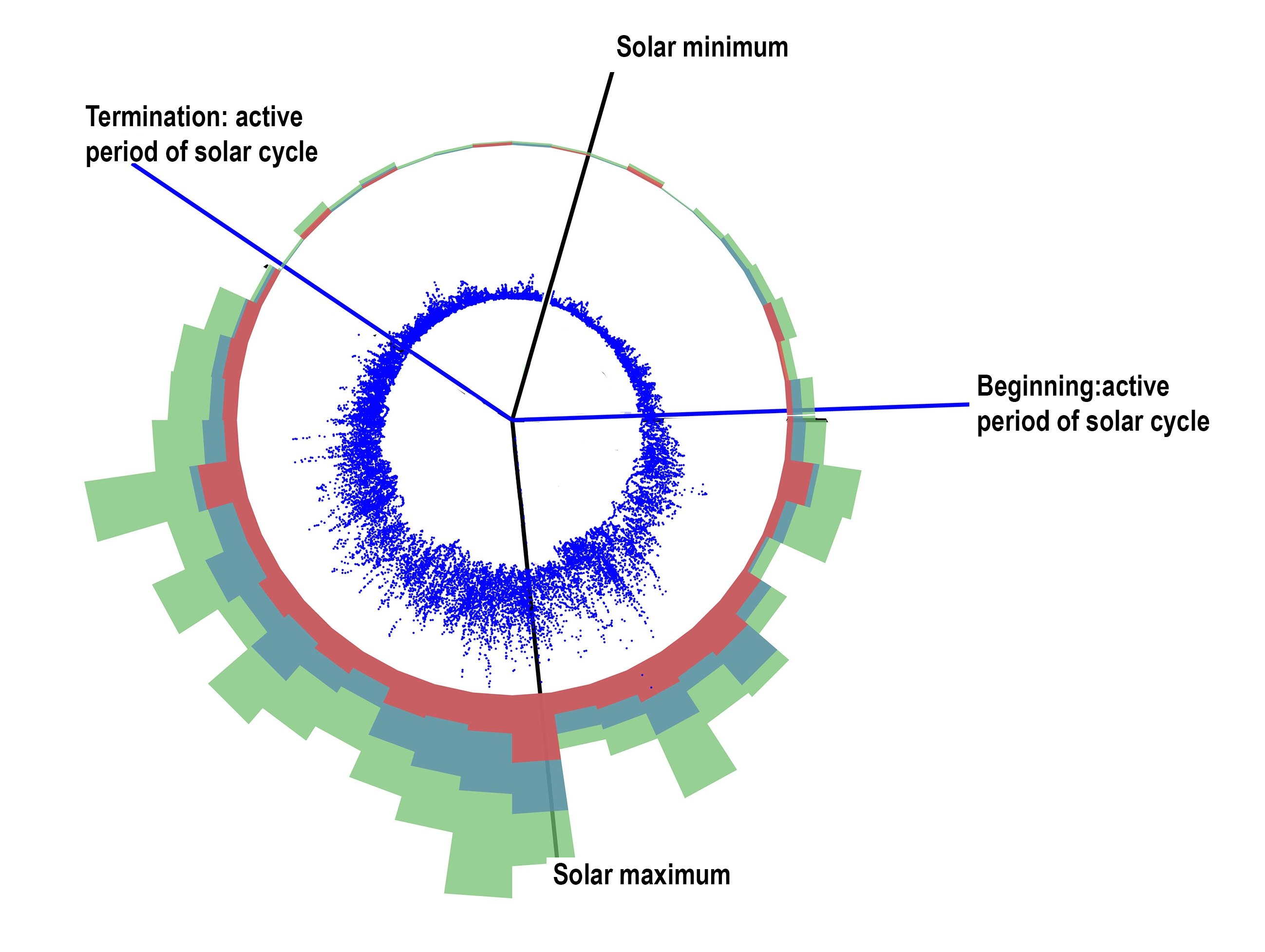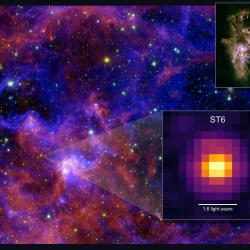New ‘Sun Clock’ Reveals that Solar Activity Turns Off and On with Surprising Precision
Clock paints picture of a more orderly, predictable sun
Solar scientists have taken a mathematical technique used by Earth scientists to analyze cyclic phenomena, such as the ebb and flow of ocean tides, and applied it to the confounding irregularity of cycles on the sun. The result is an elegant “sun clock” that shows that solar activity starts and stops on a much more precise schedule than could be discerned by looking at observations of the sun linearly over time.
The new sun clock refines the ability of scientists to predict more active periods of solar activity, which is important for protecting vital space- and ground-based technologies that are sensitive to space weather.
The new research was led by the University of Warwick in England and involved researchers from the University of Maryland, the National Center for Atmospheric Research (NCAR) and NASA. A research paper describing the work was published in the June 16, 2020, issue of the journal Geophysical Research Letters.
The rhythmic waxing and waning activity of the sun follows a cycle that takes roughly 11 years. But it can be years longer or shorter and can vary in strength. While all solar cycles build from a quiet start toward the cycle’s solar maximum before quieting again, the magnitude of that maximum can change significantly from cycle to cycle. During and after solar maximum, the sun is more likely to produce space weather that can impact Earth by damaging satellites, scrambling radio communications and disrupting power grids, among other impacts. The new sun clock could be used as a planning tool to help keep space- and ground-based infrastructure safe.
The researchers created the clock using a technique known as the Hilbert transform, which was used to convert the linear observations of past solar cycles onto a circle, stretching or compressing the years as necessary to fit a standard 11-year timeframe. When they overlaid the cycles on top of each other on the clock’s face, distinct “times” when solar activity is flipped on and off came into focus.
“It’s like looking at a traditional clock face that tells us the time of day,” said Robert Leamon, a visiting research scientist in UMD’s Department of Astronomy and a co-author of the research paper. “We can see that all the activity happens after 3:00, and by 10:00, it’s all done. So, once we know where we are on the solar clock and can calculate the speed of the cycle we’re in—in other words, the shrinking or stretching required—we can make much more precise predictions about when the next cycle of solar activity will start and stop. Given our current observations, the beginning of the next cycle is imminent, and the inactive period of the cycle will begin around the first half of 2027.”
“Scientists spend their lives trying to read the book of nature,” said Sandra Chapman, a professor at the University of Warwick who led the study. “Sometimes we create a new way to transform the data, and what appeared to be messy and complicated is suddenly beautifully simple. In this instance, our sun clock method showed clear switch on and switch off times demarcating quiet and active intervals for space weather for the first time.”
The idea of applying a Hilbert transform to solar activity data was born out of a chance meeting at a conference in 2018, when Chapman suggested that Leamon apply the transform to help make sense of another project he was working on that involved the cyclic nature of El Niño.
“The Hilbert transform is a really powerful technique across all of science," said Leamon, who is also a NASA research scientist. "When we applied it to sun spots, we saw it tied to the sharp switch on of activity that we'd seen elsewhere. Further analysis of the geomagnetic data, which measures the strength of space storms at Earth, revealed the switch off as well."
The creation of the solar clock is part of a larger body of research being undertaken by NCAR scientist Scott McIntosh to make a case that the sun’s cycles are far more predictable and regular than scientists realize. For example, McIntosh and Leamon have identified “terminator” events on the sun, which they say offer observational evidence of the start and stop of solar cycles, something that has been estimated in the past.
“The sun is not nearly as irregular as we thought,” McIntosh said. “But we’ve been looking in the wrong places. Once you realize that the sun is actually adhering to a larger cycle, and that the appearance and disappearance of sun spots are just a symptom of that cycle not the cycle itself, you see a beautiful order in the chaos. The striking regularity we find in this new sun clock is evidence of that.”
###
This story was adapted from text provided by the National Center for Atmospheric Research.
The research paper, “Quantifying the solar cycle modulation of extreme space weather,” S. C. Chapman, S. W. McIntosh, R. J. Leamon, N. W. Watkins, was published in the June 16, 2020 issue of Geophysical Research Letters.
This research was supported by the National Center for Atmospheric Research and the National Science Foundation (Award No. 1852977). The content of this article does not necessarily reflect the views of these organizations.
Writer: Kimbra Cutlip
Media Relations Contact: Abby Robinson, 301-405-5845, abbyr@umd.edu
University of Maryland
College of Computer, Mathematical, and Natural Sciences
2300 Symons Hall
College Park, Md. 20742
www.cmns.umd.edu
@UMDscience
About the College of Computer, Mathematical, and Natural Sciences
The College of Computer, Mathematical, and Natural Sciences at the University of Maryland educates more than 9,000 future scientific leaders in its undergraduate and graduate programs each year. The college's 10 departments and more than a dozen interdisciplinary research centers foster scientific discovery with annual sponsored research funding exceeding $200 million.








